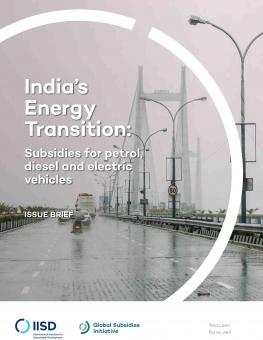
India's Energy Transition: Subsidies for gasoline, diesel and electric vehicles
India’s subsidies to petrol and diesel between October 2018 and June 2019 amounted to almost three times the three-year government budget for electric vehicle (EV) support, according to our new study.
Key Messages
- A fuel price cut by India’s central government from October 2018 to June 2019 resulted in subsidies of INR 26,957 crore (USD 3.9 billion) for gasoline and diesel.
- This far overshadowed funding for the government’s flagship electric vehicles (EV) subsidy program of INR 10,000 crore (USD 1.4 billion) over three years.
- The funds would have been better spent supporting India’s transition to EVs and renewable energy, given that together these technologies will reduce air pollution.
This brief examines how the latest support by the Government of India for electric vehicles (EVs) compares with subsidies for conventional vehicles and their main fuels, gasoline and diesel. Analysis is centred on two major policy developments.
First, when faced with rising world oil prices in October 2018, the Central Government reduced the excise tax on fuel by INR 1.5 (USD 0.02) per litre and required state-owned oil marketing companies (OMCs) to reduce their margin by INR 1 (USD 0.01). This decision was partially reversed in the 2019-2020 Union Budget.
Second, the government announced phase two of its flagship EV subsidy program, the Faster Adoption and Manufacturing of Hybrid and Electric Vehicles (FAME) scheme, or FAME II.
The rising trend for EV subsidies in India has been strengthened by the addition of INR 10,000 crore (USD 1.4 billion) for FAME II over three years. However, subsidies for oil, gasoline and diesel, which had been declining since FY 2014, have also seen a sharp increase: cuts to excise and OMC margins resulted in foregone revenue and market price support of INR 26,957 crore (USD 3.9 billion) from October 2018 to June 2019.
If improving air quality is indeed a high priority of the Central Government, as it states, the funds would have been better spent supporting India’s transition to EVs and renewable energy rather than sheltering petroleum-reliant technology from the volatile international oil market.
Participating experts
You might also be interested in
Increased Support Needed to Achieve India's Clean Energy Goals
India is on track to achieve many of its 2030 clean energy goals but needs to step up government support measures to accelerate the deployment of offshore wind, electric vehicles, and green hydrogen, according to a new report.
India Faces Clean Energy Challenges as Energy Demand Soars and Global Fossil Fuel Subsidies Rise
New research finds the global energy crisis and increasing energy demand have pushed India's energy subsidies to a 9-year high.
G20 energy ministers call for cooperation on nuclear energy & low-emission hydrogen
The Group of 20 energy ministers' meeting concluded in Goa on July 22, 2023, with the final summary failing to include language on the phase-down of unabated fossil fuels.
Implementing Solar Irrigation Sustainably
This guidebook provides recommendations to state policy-makers on how they can implement solar irrigation models, particularly decentralized solar plants for irrigation under the PM-KUSUM scheme, effectively and sustainably.